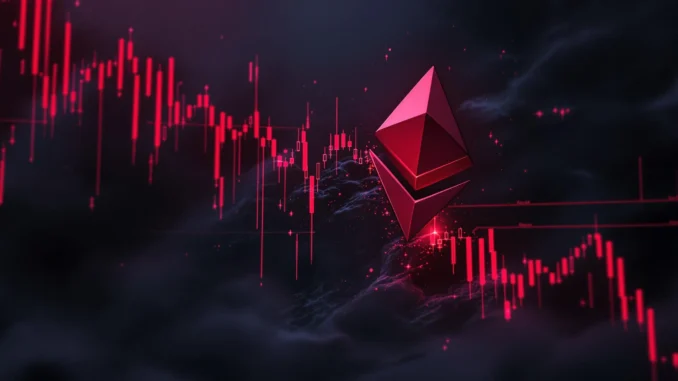
Hold onto your hats, crypto enthusiasts! The market is experiencing a rollercoaster, and Ethereum (ETH), one of the leading cryptocurrencies, is feeling the heat. A significant price drop is underway, and if ETH breaches a critical threshold, we could witness a substantial wave of on-chain liquidations. Let’s dive deep into what’s happening with Ethereum, the potential impact of this price drop, and what it means for the broader crypto landscape. Understanding Ethereum liquidations is crucial in navigating these volatile market conditions.
Why is the Ethereum Price Dropping?
Before we delve into the liquidation scenario, it’s essential to understand why Ethereum is experiencing this downward pressure. Several factors can contribute to price fluctuations in the crypto market, and Ethereum is no exception. These can include:
- Market-Wide Correction: The entire cryptocurrency market often moves in tandem. Bitcoin’s performance, macroeconomic factors, and global events can influence the sentiment and direction of the market, impacting assets like Ethereum.
- Profit Taking: After periods of price appreciation, investors may choose to take profits, leading to sell-offs and price corrections.
- Regulatory Concerns: News or announcements regarding increased regulatory scrutiny in the crypto space can create uncertainty and trigger price drops.
- Whale Activity: Large holders of Ethereum (whales) making significant sell orders can create downward pressure on the price.
- Technical Factors: Breaking below key technical support levels can trigger further selling as traders react to these signals.
Currently, according to CoinMarketCap data, Ethereum is trading at $2,072.43, marking a significant 14.81% decrease over the last 24 hours. This sharp price drop has put the spotlight on potential liquidation events.
The $1,780 Critical Level for Ethereum: A Liquidation Trigger
Data from Defillama, a reputable on-chain analytics platform, reveals a crucial price point for Ethereum: $1,780. If Ethereum’s price falls below this level, it could trigger a cascade of crypto liquidations totaling approximately $372 million. But what exactly are liquidations in the context of decentralized finance (DeFi)?
Understanding Crypto Liquidations in DeFi
In the DeFi world, especially on platforms like MakerDAO, users can borrow cryptocurrency by providing collateral, often in the form of other cryptocurrencies like ETH. These loans are typically over-collateralized to mitigate risk. Here’s a simplified breakdown:
- Collateralization: A user deposits ETH as collateral to borrow another cryptocurrency, for example, DAI (a stablecoin pegged to the US dollar).
- Loan-to-Value Ratio (LTV): Each platform has an LTV ratio, which dictates how much can be borrowed against the collateral. For instance, an 80% LTV means you can borrow up to 80% of the collateral’s value.
- Liquidation Threshold: If the value of the collateral (ETH in this case) decreases and the LTV ratio is breached (meaning the loan becomes under-collateralized), the protocol automatically liquidates the collateral to repay the loan and protect the system.
- Liquidation Penalty: Liquidations often come with penalties, meaning the borrower loses a portion of their collateral in addition to the amount needed to cover the loan.
Therefore, a significant ETH price drop can push many borrowers’ positions below the liquidation threshold, leading to automated sell-offs of their ETH collateral. This creates a negative feedback loop, further contributing to the price decline.
MakerDAO: The Epicenter of Potential Ethereum Liquidations
Defillama’s data highlights that MakerDAO is anticipated to be the platform most affected by these potential Ethereum liquidations. MakerDAO is one of the largest and most established decentralized lending platforms. It allows users to generate DAI by locking up collateral assets like ETH in vaults.
Why MakerDAO is Vulnerable to ETH Price Drops?
- Large ETH Holdings: MakerDAO holds a significant amount of ETH as collateral in its vaults, making it particularly sensitive to ETH price fluctuations.
- Popularity of ETH as Collateral: ETH is a widely accepted and popular form of collateral on MakerDAO due to its liquidity and market capitalization.
- Automated Liquidation Mechanism: MakerDAO’s robust and automated liquidation system, while designed to protect the protocol, can trigger large-scale liquidations during sharp price declines.
The concentration of potential liquidations on MakerDAO means that if ETH continues to fall and breaches the $1,780 mark, this platform could experience a substantial amount of activity related to liquidating under-collateralized positions.
What Does $372 Million in Liquidations Mean for the Crypto Market?
A $372 million liquidation event is not insignificant, even in the context of the vast cryptocurrency market. Here’s what this scale of crypto liquidations could imply:
- Increased Volatility: Large liquidations can exacerbate price volatility. The forced selling of ETH during liquidations adds further downward pressure, potentially leading to even sharper price drops.
- Market Sentiment Shift: A significant liquidation event can negatively impact market sentiment. It can create fear and uncertainty among investors, potentially leading to broader sell-offs across the crypto market.
- Stress Test for DeFi Protocols: These events serve as stress tests for DeFi protocols like MakerDAO. They highlight the importance of robust risk management and liquidation mechanisms in maintaining the stability of these platforms.
- Opportunities for Some: While liquidations can be painful for borrowers, they also present opportunities for liquidators. These are entities that participate in the liquidation process, often earning a profit by purchasing collateral at a discount.
Navigating the Ethereum Price Volatility: Tips for Crypto Users
In times of market volatility and potential Ethereum liquidations, it’s crucial for crypto users to be informed and take proactive steps to manage their risk. Here are some actionable insights:
- Monitor Your Positions: If you have DeFi positions collateralized with ETH, closely monitor your Loan-to-Value ratios. Ensure you have sufficient collateral to avoid liquidation if ETH’s price continues to decline.
- Reduce Leverage: Consider reducing leverage in your trading or DeFi positions during periods of high volatility. Lower leverage provides a greater buffer against price swings.
- Stay Informed: Keep up-to-date with market news, on-chain data, and technical analysis to understand potential price movements and risks.
- Diversify Your Portfolio: Diversification can help mitigate risk. Don’t put all your eggs in one basket. Spread your investments across different assets.
- Understand Liquidation Risks: If you are participating in DeFi lending or borrowing, thoroughly understand the liquidation mechanisms and risks associated with the platforms you use.
Is This a Buying Opportunity or a Sign of Further Decline for ETH?
The million-dollar question is whether this ETH price drop presents a buying opportunity or signals further downside. Predicting market bottoms is notoriously difficult, but here are some perspectives to consider:
Arguments for a Potential Buying Opportunity:
- Oversold Conditions: Sharp price drops can sometimes lead to oversold conditions, where the price has fallen too quickly and is due for a rebound.
- Long-Term Fundamentals: Ethereum’s long-term fundamentals, including its role in DeFi, NFTs, and the ongoing development of Ethereum 2.0, remain strong.
- Market Cycles: Cryptocurrency markets are cyclical. Bear markets and corrections are a natural part of the cycle, and historically, they have been followed by periods of growth.
Arguments for Potential Further Decline:
- Continued Selling Pressure: Liquidations and negative sentiment can create a self-fulfilling prophecy, leading to further selling pressure and price declines.
- Macroeconomic Headwinds: Broader economic factors, such as inflation and interest rate hikes, could continue to weigh on risk assets like cryptocurrencies.
- Uncertainty and Fear: Market fear and uncertainty can drive investors to the sidelines, reducing buying demand and prolonging price corrections.
Ultimately, whether this is a buying opportunity or a sign of further decline depends on a multitude of factors and individual risk tolerance. It’s crucial to conduct thorough research, consider your own financial situation, and make informed decisions.
Conclusion: Navigating the Choppy Waters of the Ethereum Market
The current situation with Ethereum’s price drop and the potential for $372 million in crypto liquidations is a stark reminder of the volatility inherent in the cryptocurrency market. While these events can be unsettling, they also present learning opportunities and highlight the importance of risk management in the DeFi space. By staying informed, understanding the dynamics of Ethereum liquidations, and carefully managing your positions, you can navigate these choppy waters and position yourself to thrive in the ever-evolving world of crypto. Keep a close watch on the $1,780 level – it could be a critical turning point for Ethereum and the broader market.



